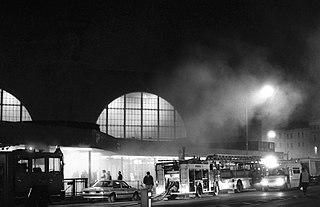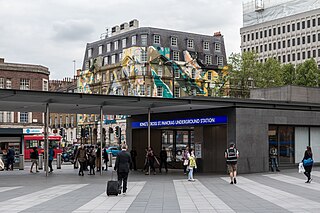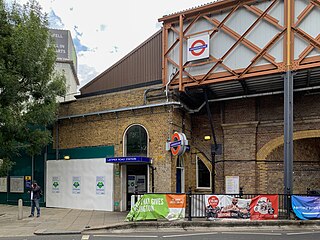
The London Underground is a rapid transit system serving Greater London and some parts of the adjacent home counties of Buckinghamshire, Essex and Hertfordshire in England.

The Waterloo & City line, colloquially known as The Drain, is a London Underground shuttle line that runs between Waterloo and Bank with no intermediate stops. Its primary traffic consists of commuters from south-west London, Surrey and Hampshire arriving at Waterloo main line station and travelling forward to the City of London financial district. For this reason, the line has historically not operated on Sundays or public holidays, except in very limited circumstances. Following the COVID-19 pandemic, the line is currently only open on weekdays. It is one of only two lines on the Underground network to run completely underground, the other being the Victoria line.

Waterloo is a London Underground station located beneath Waterloo National Rail station. As of 2022, it is the 2nd busiest station on the London Underground, with 68.72 million users. It is served by four lines: Bakerloo, Jubilee, Northern and Waterloo & City.

The King's Cross fire occurred in 1987 at King's Cross St Pancras tube station in London, England, causing 31 fatalities. It began under a wooden escalator before spreading into the ticket hall in a flashover.

Finsbury Park is an intermodal interchange station in North London for London Underground, National Rail and London Buses services. The station is the third busiest Underground station outside Zone 1, with over 33 million passengers using the station in 2019.

King's Cross St Pancras is a London Underground station on Euston Road in the Borough of Camden, Central London. It serves King's Cross and St Pancras main line stations in fare zone 1, and is an interchange between six Underground lines. The station was one of the first to open on the network. As of 2022, it is the most used station on the network for passenger entrances and exits combined.

Roding Valley is a London Underground station situated in Buckhurst Hill in the Epping Forest district of Essex, straddling the boundary between that council and Greater London. The station is on the Hainault loop of the Central line between Chigwell and Woodford stations. However, geographically it is midway between Woodford and Buckhurst Hill stations. It is located between Station Way and Cherry Tree Rise. Since 2 January 2007, the station has been in Travelcard Zone 4.

Angel is a London Underground station in the Angel area of the London Borough of Islington. It is on the Bank branch of the Northern line, between King's Cross St. Pancras and Old Street stations, in Travelcard Zone 1. The station was originally built by the City & South London Railway (C&SLR) and opened on 17 November 1901. The station served as a terminus until the line was extended to Euston on 12 May 1907.

Blackfriars, also known as London Blackfriars, is a central London railway station and connected London Underground station in the City of London. It provides Thameslink services: local, and regional and limited Southeastern commuter services to South East London and Kent. Its platforms span the River Thames, the only one in London to do so, along the length of Blackfriars Railway Bridge, a short distance downstream from Blackfriars Bridge. There are two station entrances either side of the Thames, along with a connection to the London Underground District and Circle lines.

The Glasgow Subway is an underground light metro system in Glasgow, Scotland. Opened on 14 December 1896, it is the third-oldest underground rail transit system in Europe after the London Underground and the Budapest Metro. It is also one of the very few railways in the world with a track running gauge of 4 ft. Originally a cable railway, the subway was later electrified, but the double-track circular line was never expanded. The line was originally known as the Glasgow District Subway, and was thus the first mass transit system to be known as a "subway"; it was later renamed Glasgow Subway Railway. In 1936 it was renamed the Glasgow Underground. Despite this rebranding, many Glaswegians continued to refer to the network as "the Subway". In 2003, the name "Subway" was officially readopted by its operator, the Strathclyde Partnership for Transport (SPT).

Barking is an interchange station serving the town of Barking, east London. It is served by London Underground, London Overground and National Rail main line services. It is located on Station Parade, in the town centre.

Latimer Road is a London Underground station in North Kensington, in the Royal Borough of Kensington and Chelsea. It is on the Circle and Hammersmith & City lines between Wood Lane and Ladbroke Grove stations and is in Travelcard Zone 2.

Network SouthEast (NSE) was one of the three passenger sectors of British Rail created in 1982. NSE mainly operated commuter rail trains within Greater London and inter-urban services in densely populated South East England, although the network went as far west as Exeter and also covered the inner East of England. Before 1986, the sector was originally known as London & South Eastern.

The City and South London Railway (C&SLR) was the first successful deep-level underground "tube" railway in the world, and the first major railway to use electric traction. The railway was originally intended for cable-hauled trains, but owing to the bankruptcy of the cable contractor during construction, a system of electric traction using electric locomotives—an experimental technology at the time—was chosen instead.

The Watford DC line is a suburban line from London Euston to Watford Junction in Watford, Hertfordshire. Its services are operated by London Overground. In February 2024 TfL announced a re-branding as the Lioness line.
Molly Dineen is a television documentary director, cinematographer and producer. One of Britain's most acclaimed documentary filmmakers, Dineen is known for her intimate and probing portraits of British individuals and institutions. Her work includes The Lie of the Land (2007), examining the decline of the countryside and British farming, The Ark (1993) about London Zoo during Thatcherism, and the Lords' Tale (2002), which examined the removal of hereditary peers.
The railway infrastructure of the London Underground includes 11 lines, with 272 stations. There are two types of line on the London Underground: services that run on the sub-surface network just below the surface using larger trains, and the deep-level tube lines, that are mostly self-contained and use smaller trains. Most of the lines emerge on the surface outside the Central London area.
The Moon and the Sledgehammer is a British 1971 cult documentary film directed by Philip Trevelyan and produced by Jimmy Vaughan which documents the eccentric lives of the Page family, consisting of the elderly Mr Page and his adult children Jim, Pete, Nancy and Kath, who live in a wood in Swanbrook, near Chiddingly, Sussex without mains gas, mains electricity or running water. The sons find employment by fixing mechanical things as odd jobs and maintain two traction engines.
On the London Underground, fluffer is the name given to a person employed to clean the tracks in the tunnels. The passage of the trains through the tunnels draws in dust and rubbish. Removing this debris is essential to maintain the safety of the Underground, as it would otherwise create a fire hazard.

The Tube is a 2012 documentary television series produced by Blast! Films for the BBC. It follows the staff and passengers of the London Underground as it undergoes the biggest upgrade in its history. It premiered on BBC Two on 20 February 2012 for a six-week run. According to Blast! Films's Twitter, there were no plans for a second series; however, the company produced an identically-themed series for Channel 5 in 2016.















